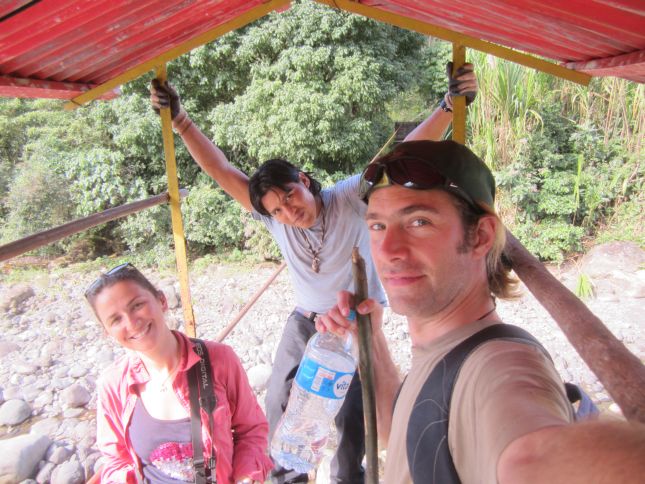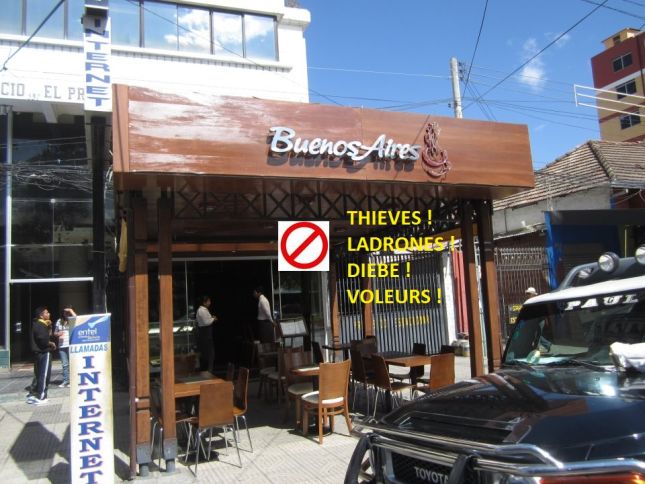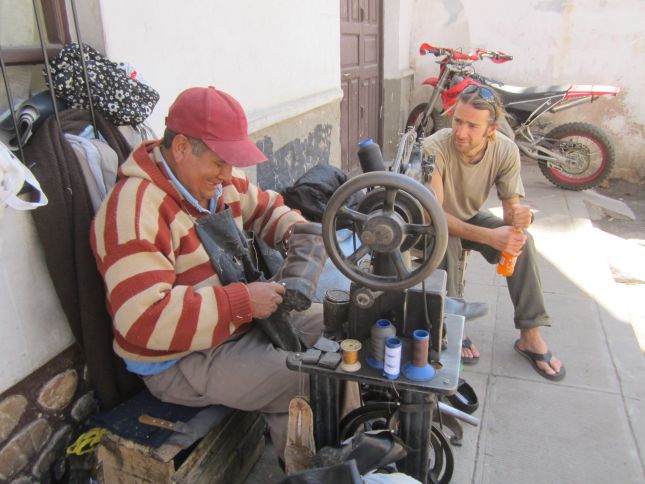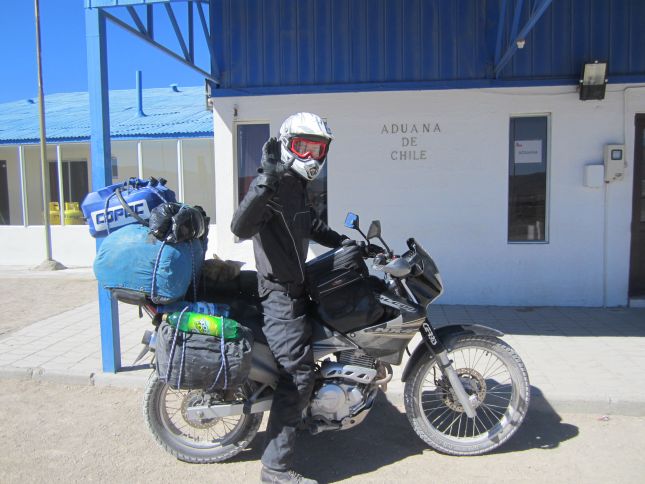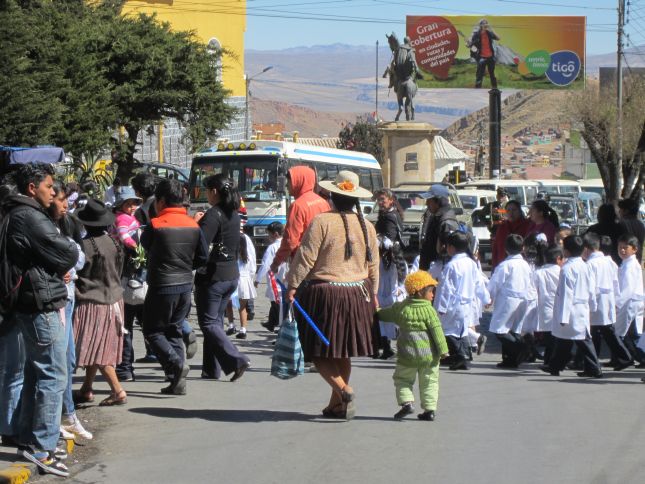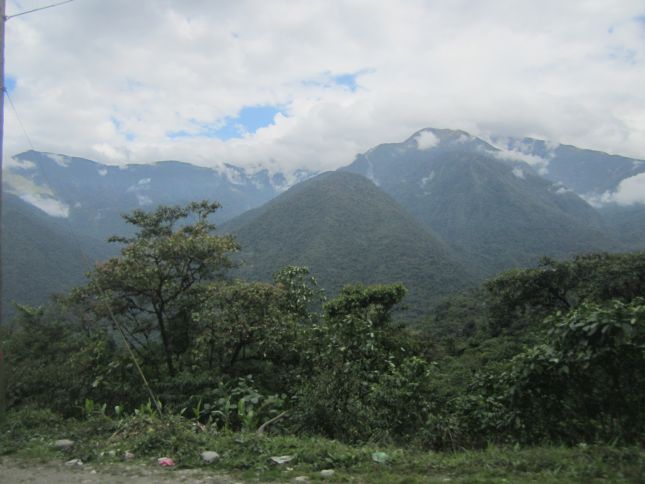
Welcome to the Jungle – Villa Tunari, Bolivia
TRIP INFO BOX |
|
| Route | Cochabamba, Bolivia – Villa Tunari, Bolivia (RN4,RN7) |
| Distance | 164Km |
| Travel Time | 4.5 hours |
| Road Conditions | Tarmac, concrete, occasionally bumpy / damaged spots |
| Weather | Overcast and windy until descent |
| Terrain | Dry mountainous into lush mountain & lowland jungle |
| Food and Petrol | Frequent |
| Accommodation | Residencial America, Villa Tunari |
From Cochabama we have a beautiful motorbike journey!
After our ordeal in Cochabamba we’ve had enough of the place and we leave the next morning. Our destination is Villa Tunari, a small town North of Cochabamba, down in the tropical jungle. All we know about this place is that it’s famous (or infamous) for its coca cultivation, which would be interesting to see, but the idea of a small town attracts us after Cochabamba. And hey it might be warm!
About an hour out of Cochabamba we come across a collection of road-side stalls where people are selling refreshments and snacks to road users. It’s overcast and a bit windy. We notice a BMW GS touring bike parked up at the stalls as we drive by and I, curious as ever, decide to pull over and say hello to our fellow rider.
As we approach them their faces look familiar – it’s Sergio and Eliena whom we met up on the Salar de Uyuni a few weeks ago! How awesome! We’re both excited to meet again and exchange hugs, hand shakes and smiles. As we consume a couple of refreshments from the stalls we exchange stories about our travels since we last saw each other. Then we ride onward together.
The descent from here to the jungle plains around Villa Tunari is more magnificent than we ever imagined. To put it into perspective, Cochabamba is at about 3000m above sea level and Villa Tunari only about 300 metres. The scenery changes from brown-yellow, bald mountains around semi-arid Cochababma to lush green cloud- and rain forest clinging to the steep slopes of the colossal Andean foothills. As we weave our way down the jungle-skirted road we get spectacular glimpses of lakes, green valleys and some unforgettable spans of road engineering across steep drops and imposing rifts in the mountains.
We’re also really excited because this is OUR FIRST VISIT TO THE AMAZON BASIN! The route is definitely one of the most beautiful we have done so far.
The road is pretty good concrete throughout, but you need to be cautious of a number of bumps, dips and rough patches along the way. In any case, these views are best enjoyed at a relaxed pace.
We stop for a break after a police checkpoint back on level ground. We chat and Sergio and gives me a few useful tips about reading tyre safety specifications. The two of them will continue on to Samaipata today, which is much further on than Villa Tunari, so we say our goodbyes again and promise to try to make it to Florianopolis to visit them.
We drive through Villa Tunari and park up at a small hut at the town limits where we notice a few European-looking folks having a drink. They turn out to be volunteers here at the Inti Wara Yassi animal rescue park. Asked about the town, they tell us that there is not much going on here, it’s very quiet, but very pleasant at the same time.
We find a perfect place to stay at Residencial America (Calle Santa Cruz esq. Hans Grether / Tel: [591]-71707096). Luis, the patron here, is a very pleasant chap and speaks good English. He welcomes us into a large, spotless room with ensuite (90BOB/night), shows us a big shared kitchen and gives us many useful tips on things to do and places to go around the area. The rest of his famliy is also very friendly but conversations are mainly in Spanish.
Indeed there is not much to do in Villa Tunari itself, but this is part of its charm. It’s a laid back jungle town at the nexus the rivers Chapare and another one, where you can enjoy nature and the pleasant climate and take it easy. We embrace the opportunity to do our own cooking again and spend a number of nights chatting to Luis over dinner or a cup of wine.
Restaurant dinner in Villa Turnari, first night, under tropical rains…
Luis tells us that this place was more visited by tourists in years-gone-by, but nowadays most of the local folk (primarily laid-off ex-miners from the altiplano) are focussed on planting coca. A chap we spoke to at a local restaurant also voiced the same concerns – the beautiful jungle plot he has had here for a decade is now totally surrounded by coca plantations and he is not happy about it as he is concerned about cartels and the changing of peoples’ attitudes. This been a major coca growing area for three decades and – after eradication efforts by the government and the US DEA ceased – coca cultivation has gone rampant since.
There is a major ongoing dispute about a highway construction (Villa Tunari-San Ignacio de Moxos) planned right through the middle of the Parque Nacional Isiboro Secure (aka TIPNIS), which is also a protected territory for the Indigenous tribes that live there. This has caused great upheavals because of the threat to the habitat of the Indigenos, as well as the concerns that the road will facilitate an increase in narco traffic and allow opportunistic cocaleros, loggers and cattle farmers to further encroach on this protected land. Several people tell us that they believe the controvercial project is unofficially aimed at serving narco traffic (the current president being from a cocalero background himself) and, furthermore, ‘pave the road’ towards future oil exploration, as apparently the area is believed to be oil- rich.
The history and fate of the Isiboro Secure is in itself a complex, fascinating and disturbing subject, which I would encourage anyone to read about. It demonstrates brilliantly how modern man is determined to destroy what treasures nature has blessed him with and how corruption and self-serving corporatocracy will successfully eradicate all beauty in the world and finally humankind itself. A plethora of websites discuss this subject, but an excellent source of well-researched information is available here (http://www.parkswatch.org/parkprofile.php?l=eng&country=bol&park=isnp&page=man)
Of course I don’t miss the opportunity to do some fishing in the beautiful rivers here, but aside from getting lots of small nibbles, all we manage to catch is a veritable rash of sandfly bites. Come prepared!!! Also among our outings in the area are are visits to:
Parque Nacional Carrasco (Click to read article)
Parque Inti Vara Yassi (Click to read article)
Isinuta and Puerto San Francisco (Click to read article)
As for the “quiet” part, we’re not sure whether we’ve been tricked or have arrived here at the wrong time. As much as we love the place, starting from the second night and going on for the following four nights until we leave, there is some fiesta going on at the local events hall around the corner, with some crazy DJ shouting and playing tunes from after sunset to about three in the morning. It’s so loud that even with ear plugs we cannot sleep. And to make it worse, once the music has stopped at 3AM and we manage to doze off, at 4AM some insane truck driver pulls up at the house opposite us to pick up his colleagues, with his radio blaring at full volume! I get out on the porch in my underpants, whistle at him and give incredulous expressions and hand gestures, but night after night it happens again. After dozing off again for an hour, a hundred cocks start crowing at 5AM sharp, after which the rest of the bird life joins in – did I mention there is a ABUNDANCE of bird life here? – and by 7AM one of the neighbours is sure to have his stereo system on.
No revolts; no massacres; no crucifictions…. how can people live like this??? Quiet town my arse!
Nevertheless, noise aside, we have a great time in Villa Tunari which we will remember fondly. The jungle climate and terrain provide a drastic change from our explorations on the altiplano and give us our first taste of what we might expect riding through the Amazon Basin. Our generous hosts at Residencial America crown the experience and make it one of our favorite destinations in South America yet.
UPDATE: we do actually return to Villa Tunari at a later stage and find that the ruccus is not a permanent feature, so rest assured that you can rest assuredly if you do visit there. 🙂
